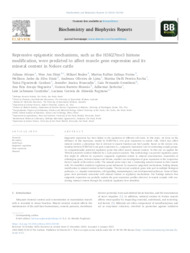Repressive epigenetic mechanisms, such as the H3K27me3 histone modification, were predicted to affect muscle gene expression and its mineral content in Nelore cattle.
Repressive epigenetic mechanisms, such as the H3K27me3 histone modification, were predicted to affect muscle gene expression and its mineral content in Nelore cattle.
Author(s): AFONSO, J.; SHIM, W. J.; BODEN, M.; FORTES, M. R. S.; DINIZ, W. J. da S.; LIMA, A. O. de; ROCHA, M. I. P.; CARDOSO, T. F.; BRUSCADIN, J. J.; GROMBONI, C. F.; NOGUEIRA, A. R. A.; MOURÃO, G. B.; ZERLOTINI NETO, A.; COUTINHO, L. L.; REGITANO, L. C. de A.
Summary: Abstract. Epigenetic repression has been linked to the regulation of different cell states. In this study, we focus on the influence of this repression, mainly by H3K27me3, over gene expression in muscle cells, which may affect mineral content, a phenotype that is relevant to muscle function and beef quality. Based on the inverse relationship between H3K27me3 and gene expression (i.e., epigenetic repression) and on contrasting sample groups, we computationally predicted regulatory genes that affect muscle mineral content. To this end, we applied the TRIAGE predictive method followed by a rank product analysis. This methodology can predict regulatory genes that might be affected by repressive epigenetic regulation related to mineral concentration. Annotation of orthologous genes, between human and bovine, enabled our investigation of gene expression in the Longissimus thoracis muscle of Bos indicus cattle. The animals under study had a contrasting mineral content in their muscle cells. We identified candidate regulatory genes influenced by repressive epigenetic mechanisms, linking histone modification to mineral content in beef samples. The discovered candidate genes take part in multiple biological pathways, i.e., impulse transmission, cell signalling, immunological, and developmental pathways. Some of these genes were previously associated with mineral content or regulatory mechanisms. Our findings indicate that epigenetic repression can partially explain the gene expression profiles observed in muscle samples with contrasting mineral content through the candidate regulators here identified.
Publication year: 2023
Types of publication: Journal article
Observation
Some of Embrapa's publications are published as ePub files. To read them, use or download one of the following free software options to your computer or mobile device. Android: Google Play Books; IOS: iBooks; Windows and Linux: Calibre.
Access other publications
Access the Agricultural Research Database (BDPA) to consult Embrapa's full library collection and records.
Visit Embrapa Bookstore to purchase books and other publications sold by Embrapa.

